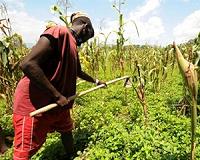 |
Sydney (AFP) Feb 2, 2011 A huge cyclone that was Wednesday set to slam into Australia's agricultural heartland could wipe half a billion dollars from its sugar industry and decimate the nation's banana crops, growers said. Top category Cyclone Yasi, which Prime Minister Julia Gillard said may be the worst in Australia's history, was on course to plough into Queensland, packing winds of nearly 300 kilometres (187 miles) per hour. Sugar group Canegrowers, whose industry dominates the region's economy, contributing just under Aus$2 billion ($2 billion) per year, fears the storm could cost at least Aus$500 million damage to the sector. Australia is the world's fourth-largest sugar exporting country according to government figures, with annual exports worth about Aus$1.7 billion to countries including Japan, South Korea and Malaysia. "The half a billion projected losses do not even start to include the cost of broader damage to infrastructure such as the road and rail network, houses, property, mills and ports," said the group's chief executive Steve Greenwood. "Some growers stand to lose 100 percent of their crop, a blow from which they may never recover," the head of the group that represents about 4,000 sugar cane growers said in a statement. About 90 percent of Australia's sugar cane is grown in Queensland, 30 percent of it north of the city of Townsville, which is home to 1,500 cane growers and which is expected to be severely hit by Yasi. Cyclone Larry, which in 2006 cut a destructive swathe across an area from south of Cairns through to near the town of Tully, north of Townsville, wiped out 40-50 percent of crops in its path, causing a loss of Aus$500 million. "There were those in Cyclone Larry who lost everything -- farmhouses, crop, machinery, sheds, and livelihood during the devastating force," said Greenwood as Yasi looked set to dwarf Larry's size and strength. There is no insurance for sugar cane growers in the region, because insuring in an area that frequently experiences cyclones is considered too risky, he said. The area between Cairns and Townsville that was shaping as ground zero for Cyclone Yasi is also the heart of Australia's banana industry, which was decimated by Larry. Some Banana growers fear they could suffer the same catastrophic losses, which sent the country's inflation soaring as shortages in key crops such as bananas put huge pressure on prices. "This will devastate the whole (banana) industry. There will be nothing standing after midnight tonight -- that's a given. It doesn't matter where it hits," said distraught banana grower Dianne Sciacca. "You only need 50 kilometre per hour winds to knock over a banana crop, a pawpaw crop and also cane," said the farmer, whose business is just recovering after losing all her crop in 2006. But the Australian Banana Growers' Council said the industry could be luckier than when Larry hit in March 2006, late in the banana season. Because it is early in the season, some growers have been able to trim young banana plants of their leaves, lessening the wind's effect, said the council's chief executive Jonathan Eccles. "They regrow a bit like when you cut the grass, they regrow fairly quickly," he said. In addition to sugar and bananas, far north Queensland is also an important producer of watermelons, mangoes, lychees, macadamia nuts, strawberries and various vegetables, the National Farmers Federation said. Economists predicted fruit prices would spike following Yasi, but said it would likely not send inflation soaring through the whole economy. The government has already warned of an inflation surge in the March quarter following record floods that swamped large farming areas south of the cyclone's path last month, wiping out fruit and vegetable plantations.
Share This Article With Planet Earth
Related Links Farming Today - Suppliers and Technology
 Innovation Of The Week: Giving Farmers A Reason To Stay
Innovation Of The Week: Giving Farmers A Reason To StayWashington DC (SPX) Feb 02, 2011 While the coast of The Gambia is a popular-and economically thriving- tourist destination for European vacationers, the inland portion of the country provides little means for young men to make a living. Many leave their villages for the coast or even other countries, in hopes of making more money in urban areas. This economic disparity within The Gambia, coupled with its agricultural pote ... read more |
|
| The content herein, unless otherwise known to be public domain, are Copyright 1995-2010 - SpaceDaily. AFP and UPI Wire Stories are copyright Agence France-Presse and United Press International. ESA Portal Reports are copyright European Space Agency. All NASA sourced material is public domain. Additional copyrights may apply in whole or part to other bona fide parties. Advertising does not imply endorsement,agreement or approval of any opinions, statements or information provided by SpaceDaily on any Web page published or hosted by SpaceDaily. Privacy Statement |